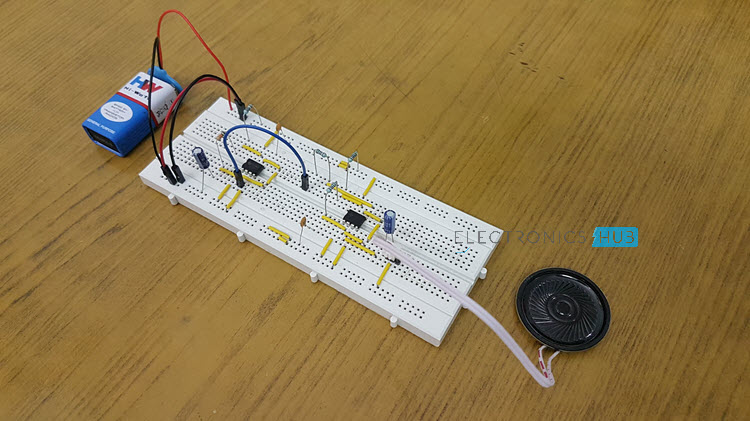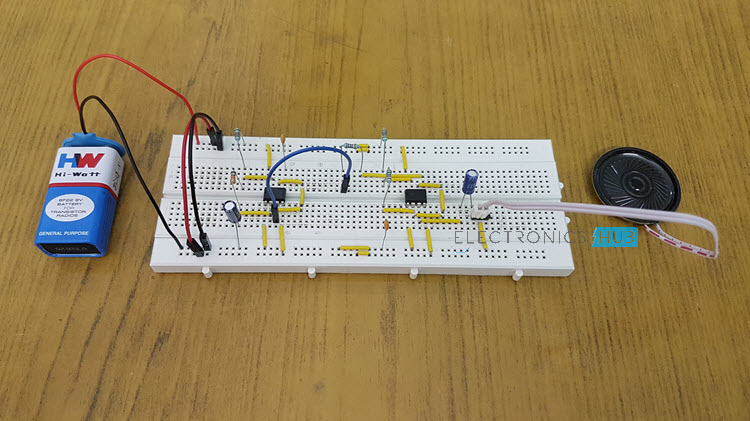In this project, I will show you how to design a simple Police Siren Circuit using NE555 Timer IC. I will also share with you how the circuit works and what is the underlying concept of the project.
The concept behind the working of this project is Multivibrator. So, before going into the details of the project, let us understand the concept of a Multivibrator.
Outline
ToggleMultivibrator
Multivibrator are found in lots of applications as they are among the most broadly used circuits. The application can be anything from a simple household application or a complex industrial or communication application. The multivibrator can also work in applications like an oscillator, digital flip flop, pulse generator circuit, timer or it can be even used in generator circuit and lots more.
There are mainly three types of Multivibrators. They are
Astable Multivibrator
It has actually no stable state. It has two quasi stable states which rapidly alters from one to another and again to the same state. So it mainly alters from high to low and from low to high irrespective of any input trigger input after a pre settled time.
Monostable multivibrator
Out of two states, one is stable state and another one is quasi stable state. When a trigger input is given, it switches from a stable state to quasi state and it automatically switches back to the stable state after a pre-decided time.
Bistable Multivibrator
Both the states are stable in it. To alter the state between low and high two different input trigger is used.
Read the post: 555 Timer as Multivibrator to understand more about 555 timer.
All the above three types of multivibrators can be easily constructed with the help of transistors. But there is one type of IC which is easily obtainable that can be used as Astable, Monostable or Bistable multivibrator and it is known as IC555.
IC555 Pin Diagram
Pin Functionality of IC555
| Provides ground | |||
| Trigger comparator input pin. Negative trigger (< 1/3 Vcc) is given in monostable operation | |||
| Its output pin | |||
| Internal flip flop reset pin. Necessity be high to enable output | |||
| Control voltage input to manage charging discharging of external capacitor | |||
| Threshold comparator input pin. Positive trigger (>2/3 Vcc) is given in bistable operation | |||
| Discharge pin. Gives discharge path to external capacitor | |||
| For +Ve biasing voltage. Between 4.5 V to 16 V |
IC 555 is one of most versatile chips and due to its multi-functionality, it can be used in almost all kinds of applications. It is a DIP or SOP package kind of chip having 8 pins with direct current drive output of 200 mA. This IC is made up of analog as well as digital components that’s why it is known as mixed signal chips. The general application of the IC is to generate timing, clock waveform, square wave oscillator and many more.
Internal Block Diagram of IC555
- Internal Block Diagram of IC 555 – ElectronicsHub.Org
As you can see from the figure above image, IC 555 comprises of two comparators one is known as RS flip flop another one is the combination of the some discrete components viz transistor, resistor and more. The voltage for biasing is parted among three parts by voltage divider having similar value of resistor R through these non-inverting voltage get 1/3 Vcc of the trigger while the inverting terminal get 2/3 Vcc of threshold comparator. R and S input terminal of the flip flop receives the both comparator output. The real output of the IC is Q’(Q bar) output while output terminal Q. The discharging transistor that gives discharging way to external capacitor at the time it reaches high.
At the time 1/3 Vcc > negative trigger is given at the input pin trigger, the trigger comparator move to high output and the flip flop reach to original sate and the chip output which is output from Q’ moves to high.
Now when 2/3 Vcc < positive trigger is given to threshold input pin, the flip flop is in set state as the output from the threshold comparator is high. The chip output moves to low as the output Q will turn to high. The external capacitor that receives the discharging path during the time of transistor discharges. The high input resets hold the flip flop to enable. At the phase of low state flip flop put out of action and receives low at the output. No other result of threshold as well as trigger comparator outputs.
Circuit Diagram of Police Siren Circuit using NE555 Timer
Components Required
- 555 Timer IC x 2
- Resistors – 1KΩ, 10KΩ x 3, 68KΩ
- Capacitors – 100nF x 2, 10µF x 2
- Mini Speaker
- 9V Battery
- Breadboard
- Connecting Wires
Working
This circuit produces a sound similar to the police siren. The 555 timer IC is an integrated circuit used in a variety of timer, pulse generation and oscillator applications. The 555 can be used to provide time delays, as an oscillator, and as a flip-flop element. I have used two 555 Timer ICs in this project and both these 555 ICs act as Astable Multivibrators.
In the beginning 555 is coupled like a low-frequency oscillator so to command the voltage at the second 555 IC at pin 5, which is a control pin. The shifting of the voltage on pin5 is the root of the second oscillator frequency to get up and down.
Police siren circuit, which is explained here, is based on the NE555 timer IC. The circuit is built with the help of two NE555 IC. Both the timer ICs in this circuit are configured as astable multivibrator. Although, both the ICs in the circuit work at two different frequencies.
The IC1 is an astable multivibrator of slow frequency and is working on a frequency of 20HZ with 50% of duty cycle while the IC2 is a fast astable multivibrator with a frequency of 600Hz. The output of the IC1 is then supplied to IC2 at its control pin (pin5). Using this arrangement, the output frequency of IC2 will be modulated with respect to the output frequency of IC1. The circuit works on the DC supply between a range of 6V to 15V.
In order to vary the frequency range of the siren, you can vary with the values of R2 and R4 resistors by replacing them with appropriate potentiometers. The pitch of the sound can be enlarged with the attachment of the power amplifier at the output. The accurate effect of police siren can be produced by connecting flashing LEDs at the correct place. The circuit can be made on a Perfboard. NE556 can be used in the place of two NE555.







9 Responses
can you show me circuit diagrame of mobile signal jammer with any example
Kindly follow the below link to get mobile signal jammer circuit diagram:
https://www.electronicshub.org/mobile-jammer-circuit/
I want LED light connection with this police siren circuit using IC555 timer. And it may blink or not
I wonder pin 6 should connect directly to the capacitor for both 555 ICs to get correct voltage.
I hooked up this circuit and I just couldn’t get it to work. I replaced most components in case they were bad (including the 555’s) to no avail. It was kind of a disappointment. I’m glad I just breadboarded it instead of a pcb. Is something wrong on the schematic?
I couldn’t get this circuit to work but finally found out what was wrong. The schematic is wrong. I disconnected pins 2 and 6 from the top side of R2 to the bottom side. I did this also for IC2 disconnecting Pin 2 and 6 from the top side of R4 to the bottom side of it. I hope you make these changes on the schematic so everyone that tries it doesn’t have to go through what I did to get it to work.
Circuit is not working
what is the value, identity of d1? noobe here
Give link to making the ir proximity sensor